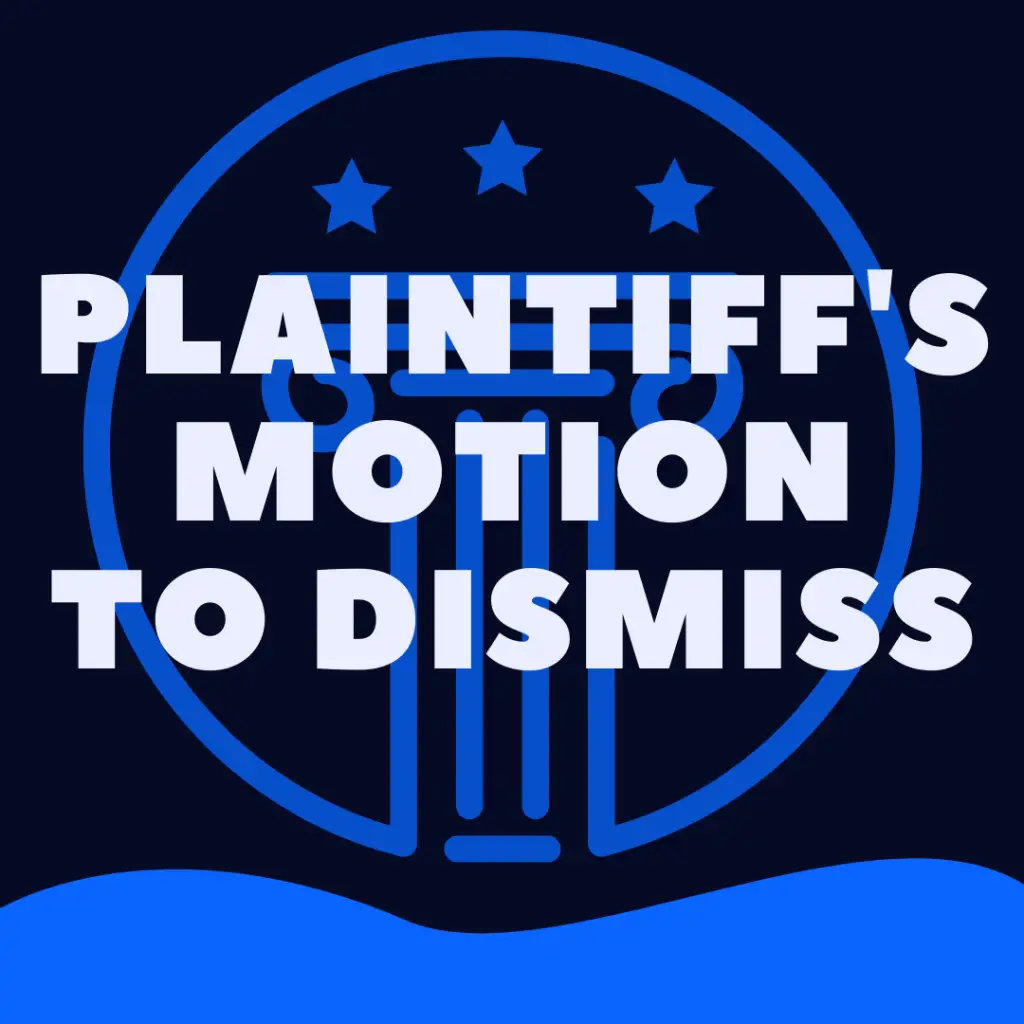How to Check When a Judge Will Review a Motion to Dismiss
Aye, a plaintiff can file a movement to dismiss.
In the article that follows, we'll explain more about what a motion to dismiss is, and how you might come across information technology filed in a civil instance.
Tin a Plaintiff File a Motion To Dismiss? (EXPLAINED)
Disclaimer
The contents of this web page are for informational purposes only, and cipher you read is intended to be legal advice. Please review our disclaimer virtually law/legal-related data on this website before taking action based upon anything you read or meet.
What Is A Motility To Dismiss?
A motion to dismiss is a procedural pace in a case pending in a court (municipal, county, state, federal, etc).
Motions to dismiss are creatures of rules that are unique to each level of court (and jurisdiction).
For example, the rules for a motion to dismiss in federal courtroom will be different from those in a California state court.
Look to the applicable "rules of civil procedure" for the reasons why a defendant may raise initial objections to the plaintiff'southward complaint, for example.
The parties to a ceremonious case would be well advised to be very familiar with the rules of civil procedure in the particular court/jurisdiction the case is in, as some of the objections that tin be raised by motion to dismissed are considered waived if they are non filed in a timely mode.
Make sure to also check the supplemental local rules of the court (or even of the specific approximate) for anything else special that needs to be filed along with a motion to dismiss.
Some common grounds for an early on motion to dismiss include: lack of personal jurisdiction, lack of subject area thing jurisdiction, bad service, wrong venue, failure to land a merits, claim has been filed besides tardily, and the case failed to bring all the necessary parties to the instance.
How Is A Motion To Dismiss Filed?
While the actual procedure varies from court to court (like some courts have platforms for electronic filing, while others require the delivery of paper copies), it mostly looks something like this:
- The political party wishing to file a motion to dismiss prepares the motion. This usually looks similar a written movement, containing the asking of the party, the relevant legal authorisation that allows the motion to be filed (statutes and case law), and a argument that the party filing really conferred with the opposing political party before filing the movement.
- If the political party filing the move hasn't attempted to confer with the opposing party, he'll practice that (a conferral is required in many courts to help resolve matters without the assistance of the judge).
- The party files the paperwork, either in person, by post, by email, by fax, or past uploading it to the filing system in the court, whichever is required.
- The political party makes sure the opposing counsel is provided a copy in whatever manner is required (physical copy mailed, past courier, via email, past fax, or via electronic filing system)
When Should A Motion To Dismiss Exist Filed?
The best time to file a movement to dismiss is when it makes sense in your example, and when in that location is potency and cause to file it.
Information technology is very mutual in civil cases for the accused's attorneys to file a motion to dismiss some or all of the plaintiff's claims before filing the defendant'due south Respond/Response.
Plaintiffs who are not familiar with civil cases may feel shock, outrage, or anxiety upon receiving these initial motions.
Merely these motions are a part of the process and happen in only about every case.
Why Would a Plaintiff File A Move To Dismiss?
At that place are lots of reasons.
Starting time, a plaintiff has the same rights as the defendant to file procedural motions to dismiss subsequently being served with a claim only before filing an answer/response.
Remember, after being served with a complaint and claims against him, the defendant has the correct (mostly) to respond and affirm his own counterclaims confronting the plaintiff.
Second, the plaintiff can determine to voluntarily dismiss his claims at simply about any betoken during the case, sometimes even without the approving and guild of the court.
3rd, it is pretty common for civil cases to terminate with a negotiated settlement somewhere forth the fashion, and it is commonly the plaintiff who files the motility to dismiss (since he can usually practise and so without the approval of the courtroom).
What Happens To The Defendant's Counterclaims If The Plaintiff Files a Motion To Dismiss?
If the plaintiff files a move to dismiss and the claims are dismissed, in general, the defendant's claims are not dismissed.
Thus, if a plaintiff files and serves a complaint confronting a accused, who so files counterclaims, a plaintiff who merely wants to end everything cannot wipe the slate clean by filing a motion to dismiss the instance.
The defendant would have to be in understanding with a dismissal of the unabridged example in order to effectuate that effect.
Wrap Up
Want to acquire more almost our justice organization?
Browse our free legal library guides for more information.
You might also like:
- Is It Illegal To Modify Lanes In An Intersection In Idaho?
- Tin The Victim Assist The Defendant'southward Instance?
- How Do Probation Officers Find Out Near New Cases?
- What Happens If The Defendant Dies?
- Can a Defense Lawyer Reject Your Case?
- Examples of Voluntary Manslaughter
- Tin can You Become To Jail For Egging a House?
- Why Are Lawyers So Expensive?

Source: https://lawstuffexplained.com/can-a-plaintiff-file-a-motion-to-dismiss/
Belum ada Komentar untuk "How to Check When a Judge Will Review a Motion to Dismiss"
Posting Komentar